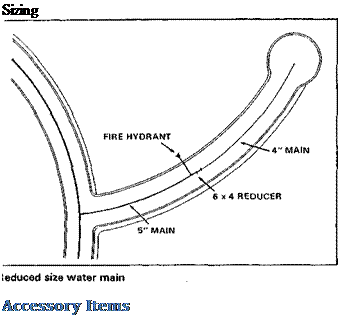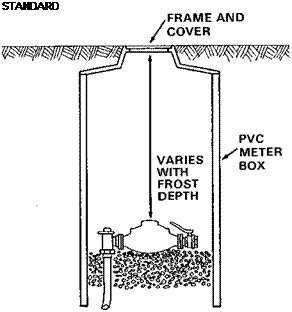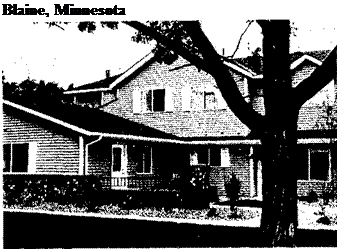WATER SUPPLY
Alternatives to traditional standards, materials, and procedures used in residential water supply systems are often more cost efficient.
Following are guidelines for water supply:
• Consider alternative materials for water mains and service pipes.
• Use multiple connections to one common service where feasible.
• Size water distribution pipes to meet the projected need.
• Substitute blow-off mechanisms for some, fire hydrants.
• Consider alternative meter arrangements.


 Pressure water pipe has been constructed of concrete, vitrified clay, lead, ductile iron, cast iron, asbestos cement, and wood. The newest material, plastic, most often in the form of polyvinyl chloride (PVC) or polybutylene (PB), has performed equally well or better than many of the more "traditional" materials.
Pressure water pipe has been constructed of concrete, vitrified clay, lead, ductile iron, cast iron, asbestos cement, and wood. The newest material, plastic, most often in the form of polyvinyl chloride (PVC) or polybutylene (PB), has performed equally well or better than many of the more "traditional" materials.
PVC is relatively light weight, easier to install, more resistant to corrosion, and less expensive than many of the alternatives. An 8-inch PVC water main will save $2.00 to $2.50 per linear foot compared with an 8-inch ductile iron water main.
Most sizes of PVC pipe can be installed without the use of expensive machinery normally required to lower the pipe into a trench, since its relatively long lengths are easily balanced against its lighter per unit weight. PVC does not require complicated mechanical or glued joints. The bell and О-ring joints of standard PVC water pipe are wedged into place, saving material and labor costs.
An alternative to relatively expensive copper tubing for service lines is plastic tubing, usually manufactured from polyethylene (PE) or polybutylene (PB). Estimated savings of replacing 1-inch type К copper tubing with 1-inch plastic tubing is between $1.50 and $2.00 per linear foot.
![]()
 Although local acceptance of plastic has been a slow process, both materials have been recognized under the major model plumbing codes. Available from most local suppliers, PB and PE have been rated at pressures well above those encountered in public water systems. Plastic tubing is flexible, lightweight, and easily joined with standard fittings. The relatively long lengths of most tubing insure that the number of joints will generally be limited to those at the main and the meter.
Although local acceptance of plastic has been a slow process, both materials have been recognized under the major model plumbing codes. Available from most local suppliers, PB and PE have been rated at pressures well above those encountered in public water systems. Plastic tubing is flexible, lightweight, and easily joined with standard fittings. The relatively long lengths of most tubing insure that the number of joints will generally be limited to those at the main and the meter.
Saddle-type connections can be eliminated where a service line taps into the water main. A corporation stop assembly, used when tapping into ductile iron pipe, provides a complete, tight fitting connection without the saddle. The saddle adds $20 to $30 per tap, depending upon local factors. Crimping of tubing, especially near the tap, can be avoided by bedding the area within a foot or two of the connection with a local aggregate.

|
Communities should reevaluate standards that require a separate tap for each residence. Тар-in costs can be reduced significantly by branching off a tap to service more than one building or home. Multiple connections to one common service are frequently used with no adverse impact on performance.
A single water service can be installed along the common property line of adjoining lots. A standard wye or tee is used to branch off the common line near the meter, reducing the number of taps by 50 percent. Trenching costs and maintenance costs are also reduced since only one line is installed for two homes.

Common water service lines can serve a number of homes in cluster or. townhouse developments. A larger branch than the typical 3/4-inch service line may be required if more units are to be served. Cost benefits of multiple service lines are directly proportional to the number of units each line serves.
Multiple connections to a single water service line
 Many communities’ standards require a 6-inch, 8-inch, or even 10-inch minimum diameter for water mains. This often produces an overdesigned system.
Many communities’ standards require a 6-inch, 8-inch, or even 10-inch minimum diameter for water mains. This often produces an overdesigned system.
Residential water supply and fire flow requirements should determine the size of water distribution piping. These requirements can often be met on short runs with 2-inch to 4-inch water lines. A larger main is generally nearby if it is necessary to install a hydrant for fire protection.
Cost savings are estimated at $4.50 per foot when a З-inch line is used compared to a 6-inch line.
Cost effective materials and construction techniques can be applied to meters, valves, hydrants and fittings. ;
Fire hydrants are routinely installed at the terminal end of water lines and at low lying points where it may be necessary to blow off the line. A blow-off mechanism can be substituted for hydrants that are not required for fire protection, saving approximately $1,000 per hydrant. A standard 2- inch blow off is usually adequate and can be installed by extending the main I with a short section of 2-inch tubing.



![]()
An outdoor type water meter enclosed in a plastic meter box eliminates both the remote reader and the curbstop shut-off commonly installed with an indoor water meter, saving approximately $60.
АІ a safeguard against freezing in colder climates, the top of the meter is covered and placed below iocal frost depth.

Multiple meters can be housed in a single box, especially efficient when multiple connections are made to a single tap.
![]()



In Lynton Place, built by the John Crosland Company, two major revisions to the city’s water main construction standards were proposed and subsequently approved by the city.
The first revision permitted a substitution of PVC water pipe for the cluctile iron pipe (DIP) water mains usually required. The second change permitted a common service line to serve two homes. This variance, which eliminated the need for two individual taps (and one tap fee), was achieved through the installation of a single 1-inch service line in place of two 3/4-inch lines. The innovations to the water system resulted in a reduction in total costs of $8,310, a savings of approximately $554 per unit.
In Mesa County, Colorado, water service to an individual building is typically installed using asbestos cement pipe. The county allowed Roger Ladd and Company to use polybutylene water service lines at the Coventry Club subdivision, resulting in a total savings of over $3,100 or approximately $63 per unit.


 Mike Robinson, President of Black Bull Enterprises, proposed substituting PVC water mains in place of the standard DIP in the North Meadow Village demonstration subdivision, and downsizing the water main from 8-inch lines to 6-inch fire hydrant and 4-inch domestic water lines, depending on the location. The city allowed both deviations from existing standards and permitted the elimination of individual meters for each unit with the understanding that the home owners’ association would maintain the system as privately owned. Water lines outside of the ROW were allowed based on the private ownership of the system.
Mike Robinson, President of Black Bull Enterprises, proposed substituting PVC water mains in place of the standard DIP in the North Meadow Village demonstration subdivision, and downsizing the water main from 8-inch lines to 6-inch fire hydrant and 4-inch domestic water lines, depending on the location. The city allowed both deviations from existing standards and permitted the elimination of individual meters for each unit with the understanding that the home owners’ association would maintain the system as privately owned. Water lines outside of the ROW were allowed based on the private ownership of the system.
The total water distribution system savings at North Meadow Village were estimated at $1,283 per unit. This reduction was after the inclusion of a $72,500 lawn sprinkler system. Had the $72,500 been excluded from the demonstration cost calculations, savings reflected in the per unit cost would have increased significantly.
The city allowed John Phillips, the builder, to install water mains outside the rights-of-way as long as easements were provided and the mains were in reasonably accessible locations.

![]() Phillips also hooked one water line into two, three, or four water meters, meaning one tap and one corporation stop would serve as many as four dwellings. By placing four meters on a single tap, cost per unit was reduced from $530 to $211. This technique was practical only because the units were grouped and clustered. Total water service costs were reduced over $40,000.
Phillips also hooked one water line into two, three, or four water meters, meaning one tap and one corporation stop would serve as many as four dwellings. By placing four meters on a single tap, cost per unit was reduced from $530 to $211. This technique was practical only because the units were grouped and clustered. Total water service costs were reduced over $40,000.
Good Value Homes (GVH),
"•builder/developer of the Cloverleaf Farm 9th Addition, installed a 11/2- inch diameter water supply line to each eight-plex unit instead of the normal 2-inch line.
GVH also clustered the shut-off valves in one central location, and installed one water meter per building instead of the typical one meter per unit.
William R. Hauke, Hauke Building Supply, was permitted by the city to use one water line for four units in his infill demonstration, saving approximately $3,000.
Plastic pipe was also used in the following demonstrations: Oklahoma City, Oklahoma; Everett, Washington; and Charlotte, North Carolina







Leave a reply